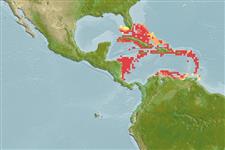>
Holocentriformes (Squirrelfishes, soldierfishes) >
Holocentridae (Squirrelfishes, soldierfishes) > Holocentrinae
Etymology: Neoniphon: Greek, neos = new + Greek, niphon = to snow (Ref. 45335).
More on author: Cuvier.
Environment: milieu / Zona climática / intervalo de profundidade / distribution range
Ecologia
marinhas associadas(os) a recifes; intervalo de profundidade 1 - 70 m (Ref. 9710), usually 30 - 60 m (Ref. 9710). Tropical; 27°N - 10°N, 85°W - 60°W
Western Atlantic: Florida Keys, USA and Bahamas to Trinidad. Antilles and throughout Caribbean (Ref. 26938).
Tamanho / Peso / Idade
Maturidade: Lm ? range ? - ? cm
Max length : 18.0 cm TL macho/indeterminado; (Ref. 26340)
Espinhos dorsais (total) : 11; Raios dorsais (total) : 12 - 14; Espinhos anais: 4; Raios anais : 9. Body striped with red, yellow and silver; often anterior third of body more yellow than remainder. Third anal ray spine very long and stout (Ref. 26938). Body slender, spiny dorsal fin with broad yellow band along middle and lower sides (Ref. 37108).
Body shape (shape guide): fusiform / normal.
Rarely found in shallow water, but appears to be the most common squirrelfish in the depth range of 30-60 m or more (Ref. 32). Reported used as food fish (Ref. 37108).
Ciclo de vida ou comportamento de acasalamento
Maturidade | Reprodução | Desova | Ovos | Fecundidade | Larvas
Böhlke, J.E. and C.C.G. Chaplin, 1993. Fishes of the Bahamas and adjacent tropical waters. 2nd edition. University of Texas Press, Austin. (Ref. 5521)
Status na Lista Vermelha da UICN (Ref. 130435: Version 2025-1)
Ameaça para os humanos
Harmless
Uso pelos humanos
Pescarias: pouco comercial
Ferramentas
Relatórios especiais
Baixar XML
Fontes da internet
Estimates based on models
Preferred temperature (Ref.
123201): 23.7 - 27.7, mean 26.6 °C (based on 29 cells).
Índice de diversidade filogenética (Ref.
82804): PD
50 = 0.5039 [Uniqueness, from 0.5 = low to 2.0 = high].
Bayesian length-weight: a=0.01585 (0.00766 - 0.03278), b=2.97 (2.79 - 3.15), in cm total length, based on LWR estimates for this (Sub)family-body shape (Ref.
93245).
Nível Trófico (Ref.
69278): 3.6 ±0.4 se; based on diet studies.
Resiliência (Ref.
120179): Elevada, tempo mínimo de duplicação da população menor que 15 meses (Preliminary K or Fecundity.).
Fishing Vulnerability (Ref.
59153): Low vulnerability (10 of 100).
🛈
Nutrients (Ref.
124155): Calcium = 82.3 [37.2, 256.7] mg/100g; Iron = 0.795 [0.331, 1.616] mg/100g; Protein = 18.5 [17.3, 19.7] %; Omega3 = 0.18 [0.07, 0.43] g/100g; Selenium = 36.2 [21.2, 69.5] μg/100g; VitaminA = 76.3 [29.6, 206.6] μg/100g; Zinc = 1.5 [1.0, 2.3] mg/100g (wet weight);
